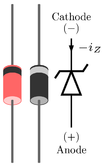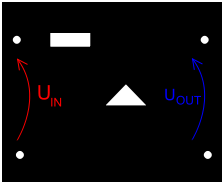Uses

Zener diode shown with the typical packages. Reverse current - iZ is shown.
Zener diodes are broadly used as voltage references and as shunt regulators to regulate voltage across small circuits. When connected in the parallel with a variable voltage source so that it becomes reverse biased, a Zener diode conducts when voltage reaches the diode's reverse breakdown voltage. From that point, the relatively low impedance of the diode keeps the voltage across diode at that value.

In the circuit, a typical voltage reference or regulator, an input voltage, UIN, is regulated down to the stable output voltage UOUT. The intrinsic voltage drop of the diode D is stable over a wide range of current and holds UOUT relatively constant even though the input voltage fluctuate over the wide range. Because of the low impedance of diode when operated like this, Resistor R is used to limit the current through the circuit.
In the case of this reference, the current flowing in diode is determined using Ohms law and the known voltage drop across resistor R. IDiode = (UIN - UOUT) / RΩ
The value of R should satisfy two conditions:
1. R should be small enough that the current through D keeps D in the reverse breakdown. The value of this current can be given in the data sheet for D. For instance, the common BZX79C5V6[2] device, a 5.6 V 0.5 W Zener diode, has a recommended reverse current of 5 mA. If the insufficient current exists through D, then UOUT will be unregulated, and lower than the nominal breakdown voltage (this differs to voltage regulator tubes where the output voltage will be higher than the nominal and could rise as high as in UIN). When calculating R, allowance should be made for any current through the external load, not shown in the diagram, connected across UOUT.
2. R should be large enough that the current through D does not destroy device. If the current through D is ID, its breakdown voltage VB and its maximum power dissipation PMAX, then IDVB < PMAX.
A load can be placed across the diode in this reference circuit, and as long as the zener stays in the reverse breakdown, the diode will give a stable voltage source to the load.
A Zener diode used in this way is called as a shunt voltage regulator (shunt, in this context, meaning connected in parallel, andvoltage regulator being a class of circuit which produces a stable voltage across any load). In a sense, a portion of the current through the resistor is shunted through Zener diode, and the rest is through load. Thus the voltage which the load observes is controlled by causing some fraction of current from the power source to bypass it -hence the name, by analogy with the locomotive switching points.
Shunt regulators are simple, but the requirements which the ballast resistor be small enough to avoid unnecessary voltage drop during worst-case operation tends to leave a lot of current flowing in diode much of the time, making for a fairly wasteful regulator with the high quiescent power dissipation, only suitable for the smaller loads.
Zener diodes in this configuration are frequently used as stable references for more advanced voltage regulator circuits.
These devices are also encountered, typically in the series with a base-emitter junction, in transistor stages where selective choice of the device centered on avalanche/Zener point can be used to introduce the compensating temperature co-efficient balancing of transistor PN junction. An instance of this kind of use would be a DC error amplifier used in the stabilized power supply circuit feedback loop system.
Zener diodes are also used in the surge protectors to limit transient voltage spikes.
Another important application of zener diode is that the use of noise caused by its avalanche breakdown in the random number generator which never repeats.
Email based Electronics Devices and circuits assignment help - homework help at Expertsmind
Are you searching Electronics Engineering assignment help expert for help with Uses of Zener Diode questions? Uses of Zener Diode topic is not easier to learn without any external help? We at www.expertsmind.com offers free lecture notes for Electronics Devices and circuits assignment help and Electronics Devices and circuits homework help. Live tutors are available 24x7 hours for helping students in their Uses of Zener Diode related problems. We provide step by step Uses of Zener Diode question's answers with 100% plagiarism free content. We prepare quality content and notes for Uses of Zener Diode topic under Electronics Devices and circuits theory and study material. These are avail for subscribed users and they can get advantages anytime.
Why Expertsmind for assignment help
- Higher degree holder and experienced experts network
- Punctuality and responsibility of work
- Quality solution with 100% plagiarism free answers
- Time on Delivery
- Privacy of information and details
- Excellence in solving electronics engineering questions in excels and word format.
- Best tutoring assistance 24x7 hours